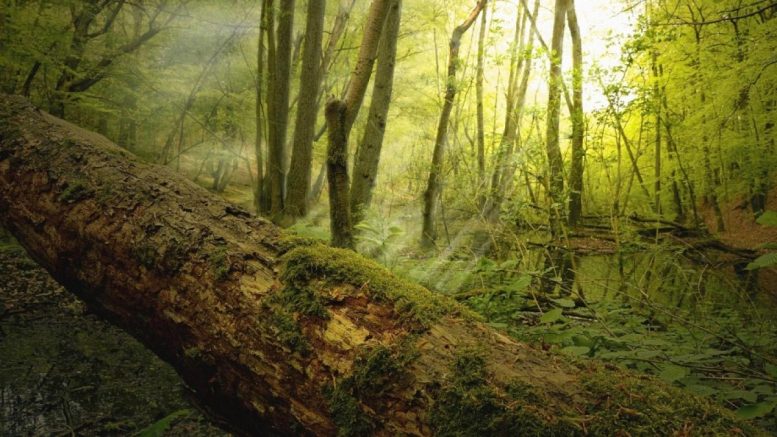Deadwood Releasing 10.9 Gigatons of Carbon Every Year – More Than All Fossil Fuel Emissions Combined
TOPICS: Australian National University Climate Change Forests Popular
By AUSTRALIAN NATIONAL UNIVERSITY SEPTEMBER 20, 2021
 Credit: Australian National University Credit: Australian National University
Decaying wood releases around 10.9 gigatons of carbon worldwide every year, according to a new study by an international team of scientists.
This is roughly equivalent to 115 percent of fossil fuel emissions.
Co-author of the study Professor David Lindenmayer from The Australian National University (ANU) says it’s the first time researchers have been able to quantify the contribution of deadwood to the global carbon cycle.
“Until now, little has been known about the role of dead trees,” Professor Lindenmayer said.
“We know living trees play a vital role in absorbing carbon dioxide from the atmosphere. But up until now, we didn’t know what happens when those trees decompose. It turns out, it has a massive impact.”
Professor Lindenmayer said the decomposition is driven by natural processes including temperature and insects.
“The decomposition of wood and the recycling of those nutrients is a critically important process in forests,” he said.
The research showed decomposition can’t happen without wood-boring insects such as Longicorn Beetles.
“We knew insects such as termites and wood-boring Longicorn beetles can accelerate deadwood decomposition,” study co-author Dr. Marisa Stone from Griffith University said.
“But until now, we didn’t know how much they contribute to deadwood carbon release globally.
“Insects accounted for 29% of deadwood carbon release each year. However, their role was disproportionately greater within the tropics and had little effect in regions of low temperatures.”
The global research project encompassed 55 forest areas on six continents. The research team studied wood from more than 140 tree species to determine the influence of climate on the rate of decomposition.
“Half the wood was placed in mesh cages which kept out insects, allowing us to study their contribution,” Professor Lindenmayer said.
“We found both the rate of decomposition and the contribution of insects are highly dependent on the climate, and will increase as temperatures rise. Higher levels of precipitation accelerate the decomposition in warmer regions and slow it down in lower temperature regions.”
Tropical forests contribute 93 percent of all carbon released by deadwood, due to their high wood mass and rapid rates of decomposition.
The study was led by Dr. Sebastian Seibold from the Technical University of Munich.
“At a time of global change, we can see some dramatic declines in biodiversity and changes in climate,” Dr. Seibold said.
“This study has demonstrated that both climate change and the loss of insects have the potential to alter the decomposition of wood, and therefore, carbon and nutrient cycles worldwide.”
The study has been published in Nature.
Reference: “The contribution of insects to global forest deadwood decomposition” by Sebastian Seibold, Werner Rammer, Torsten Hothorn, Rupert Seidl, Michael D. Ulyshen, Janina Lorz, Marc W. Cadotte, David B. Lindenmayer, Yagya P. Adhikari, Roxana Aragón, Soyeon Bae, Petr Baldrian, Hassan Barimani Varandi, Jos Barlow, Claus Bässler, Jacques Beauchêne, Erika Berenguer, Rodrigo S. Bergamin, Tone Birkemoe, Gergely Boros, Roland Brandl, Hervé Brustel, Philip J. Burton, Yvonne T. Cakpo-Tossou, Jorge Castro, Eugénie Cateau, Tyler P. Cobb, Nina Farwig, Romina D. Fernández, Jennifer Firn, Kee Seng Gan, Grizelle González, Martin M. Gossner, Jan C. Habel, Christian Hébert, Christoph Heibl, Osmo Heikkala, Andreas Hemp, Claudia Hemp, Joakim Hjältén, Stefan Hotes, Jari Kouki, Thibault Lachat, Jie Liu, Yu Liu, Ya-Huang Luo, Damasa M. Macandog, Pablo E. Martina, Sharif A. Mukul, Baatarbileg Nachin, Kurtis Nisbet, John O’Halloran, Anne Oxbrough, Jeev Nath Pandey, Tomáš Pavlícek, Stephen M. Pawson, Jacques S. Rakotondranary, Jean-Baptiste Ramanamanjato, Liana Rossi, Jürgen Schmidl, Mark Schulze, Stephen Seaton, Marisa J. Stone, Nigel E. Stork, Byambagerel Suran, Anne Sverdrup-Thygeson, Simon Thorn, Ganesh Thyagarajan, Timothy J. Wardlaw, Wolfgang W. Weisser, Sungsoo Yoon, Naili Zhang and Jörg Müller, 1 September 2021, Nature.
DOI: 10.1038/s41586-021-03740-8
We recommend
New Study Reveals Cause of Earth’s Recent Record Carbon Dioxide Spike
James Kelly, SciTechDaily, 2017
Diseased Trees May Be a Significant Source of Methane that Causes Climate Change
Staff, SciTechDaily, 2012
Tropical Forests’ Carbon Sink Is Rapidly Weakening – Crucial for Stabilizing Earth’s Climate
Mike O'Neill, SciTechDaily, 2020
Impact of Large-Scale Tree Death on Carbon Storage Shown
Mike ONeill, SciTechDaily, 2019
New Research: Trees Absorb Less Carbon Dioxide As the World’s Temperature Rises
Mike ONeill, SciTechDaily, 2020
|





